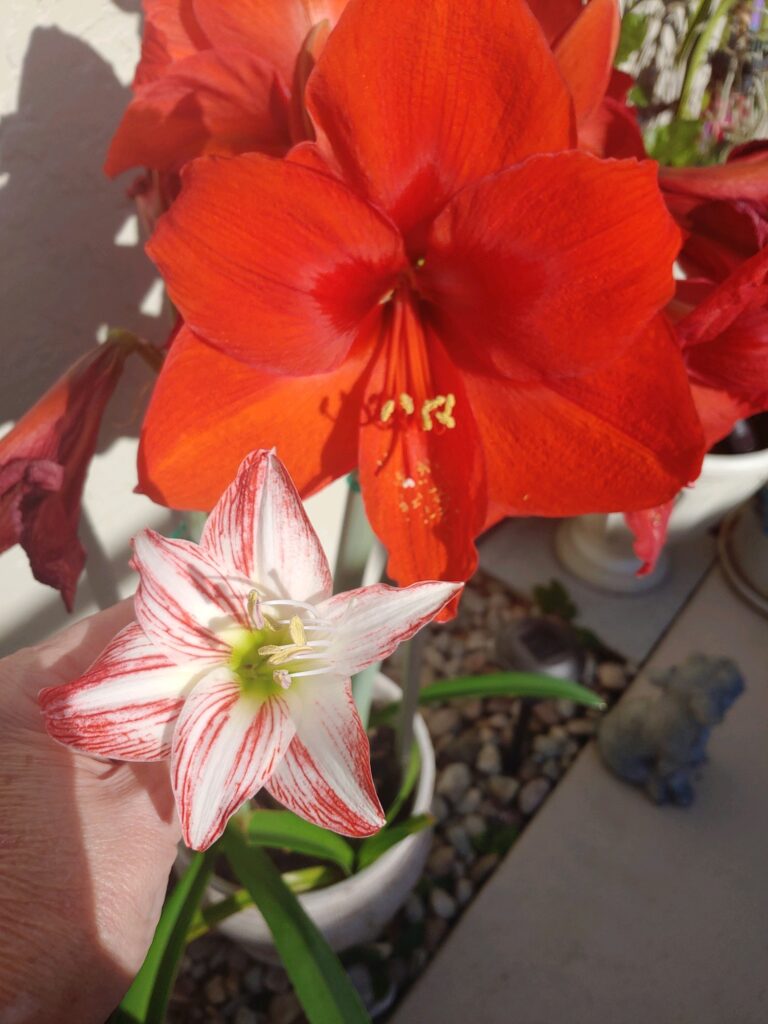For the Love of Amaryllis


Tasha Brigg’s recent blooms. [Submitted]
One hundred and fifty years ago, a boat from Denmark arrived in New York Harbor—onboard was the young immigrant, Thorwald Andrew Petersen, Tasha Brigg’s great grandfather. He disembarked with few possessions, but among them were his prized amaryllis (lily) bulbs—predecessors of the giant red variety on Brigg’s back patio.
Briggs, owner of Ocala’s Dive Patches International, carries on her great-grandfather’s love of the amaryllis. She tells the story of Petersen, who capitalized on his love for the lily and soon founded an amaryllis farm in Summerfield. Petersen’s unnamed farm was located on land that is now Bridle Trail Estates near The Villages.
“A few of the bulbs were passed down to my grandmother. Then to my mother, and now to me,” she said.
And now Briggs cultivates the bulbs on her patio.
“I really don’t do anything special, besides water and put a little fertilizer on occasion.”
While Amaryllis lilies have bloomed out for this year, the blooming season is between December to June, it is not too soon to begin ordering from online sources. Beginning in November, boxed bulbs will begin to appear on shelves in the big box stores, but by getting your foot in the door with the bulb companies, you can get on their “send when ready” shipping list.
Amaryllis, a trumpet-shaped lily, can be found in single or double varieties. According to IFAS (Institute of Food and Agricultural Sciences) publication 1243, amaryllis bulbs are available in red, bright pink, orange, pink, rose, salmon, and pure white. One old-Florida backyard variety, (the family Amaryllidaceae is native to South America) is orange with white stripes.
Amaryllis are easy to grow. They do not require a lot of care. Planted in the ground, their leaves will die back in the winter and come back in the spring with blooms.

Three generations of amaryllis lovers at the family’s Summerfield amaryllis farm. Tasha Brigg’s great-grandfather Thorwald Andrew Petersen and great-grandmother Peterson are on the right. Her grandmother and grandfather are on the left. Tasha Brigg’s mother is in front along with her siblings. Amaryllis lilies line the fence behind them.
Though Amaryllis can be planted or transplanted any time of the year in Florida, it is best to do so in the winter while they are dormant. You will want to plant your bulb neck deep, root-side down, pointed side up. The bulbs like a well-drained soil. Keep damp, but not soggy, until established.
If transplanting, be careful to dig wide, (do not pull), as the roots may be more extensive than you expect. You may be happy to note that some bulbs will have produced bulblets, or little ones.
However, according to IFAS circular No. 1243 “It is not necessary to dig, separate, and replant each year, but if the bulbs are crowded, doing so will encourage uniform flowering and larger blooms.” Digging, though, will allow you to remove the bulblets (for planting elsewhere) and add some needed organic matter.
A balanced 10-10-10 fertilizer with micronutrients is recommended, at least once in the spring, and two or three times during the growing season ending in September.
For maximum blooms next year, cut off bloom stalks when all the flowers have died.
Amaryllis are easily grown in pots. However, follow Briggs’ example and choose heavy pots, as hearty bloom stalks can topple a lightweight container. After two or more years repot to avoid crowding and maintain large blooms.
For more information explore https://edis.ifas.ufl.edu/publication/EP060, or https://gardeningsolutions.ifas.ufl.edu/plants/ornamentals/amaryllis.html
Jennifer Odom is an avid gardener and an Ocala-based author. Her novels “Summer on the Black Suwannee and “Stranger with a Black Case” are available now. For information visit jenniferodom.com





